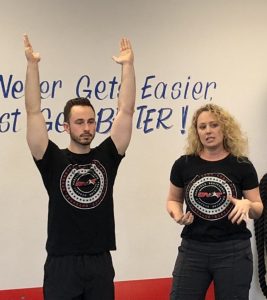Ultimate Sandbag Exercises for Neutral Spine
2018-10-23
Jessica Bento, Physical Therapist (Creator DVRT Restoration, DVRT Shoulder Course, DVRT Pelvic Control Course)
It is a question I hear a lot, especially being a physical therapist. “How do I help people find neutral spine?” Ten years ago I probably would have given you a drastically different answer than I would today. There would have been a lot of trying to get people to move around their pelvis and communication with people that went something like, “move the hips more forward, no back, no a bit more forward, stand taller, no not THAT tall.” I think anyone who has taught the idea of neutral spine has gone through a similar process. That’s why with DVRT Ultimate Sandbag exercises I have much better tools to help people understand neutral spine.
One of the things that we have to agree upon first though its that neutral spine isn’t an exact position. Unless we start doing imaging upon people’s spines or start using goniometers to measure, it can be really hard to truly find neutral spine. The bigger question is “does it really matter?” When I first became a therapist I might have lectured you on the absolute nature of having to hold neutral spine. As I have treated so many people, what I found is really important is looking for rather large deviations from the point where we consider good postural alignment.

Don’t worry if this seems confusing, we are going to make it simple soon!
I realize that posture has had people go back and forth on its value, but I believe that comes down to people trying to be too exact on something that is slightly different for everyone. Posture does matter and what matters most is looking for significant changes from good postural alignment. How do you know something is “significant”? I think most people can see it, from very exaggerated curves to one’s low back, to very slumped shoulders, to head postures that are far head of the body.
Of course there will be someone out there that tries to say there is not science that posture impacts health. Let me put it this way, there is no guarantee that smoking cigarettes will give you cancer. However, there is a much higher risk of developing cancer if you do smoke. Similar idea with really bad posture, then we also have to ask ourselves, how does that help someone?
With all that said, let’s go back to helping people find a position of more neutral spine. Why do we care? It generally it will allow people to use the right muscles during movement, it will take some pressure off joints that are not meant to bear such loads. Few “bad things” ever happen from having people work from a more neutral spine position.
If we want to think in the most simple of terms, if we see the typical position where our chest looks REALLY big and there appears to be a big curve in our low back we are lengthening the abdominal wall which makes it very hard for it to create stability for our spine. Make sense?
Then the question becomes how do we teach this to people? First off, we have to realize that a few hours a week can be hard to combat hours upon hours of sitting. So, you may have to use these exercise and drills in between sitting sometimes.
Where most people struggle in helping people find their neutral spine is they cue the movement of the hips, rather than thinking, “how did the hips get there?” That is why we designed DVRT Ultimate Sandbag exercises to be great feedback tools to help people learn how to use their bodies better and create faster solutions.
For example, when standing your pelvis doesn’t just decide to be in one position or not by itself. It is above a whole series of joints that impact the position of the pelvis, especially the feet! That is why we use specific cues and tools in our DVRT Ultimate Sandbag exercises to realize how we don’t focus just on the hips but the entire chains of the body.
https://www.instagram.com/p/BlK_L3sjOwy/?utm_source=ig_web_copy_link
You can see in DVRT Ultimate Sandbag exercises like these Press Out Squats with mini bands that the bands around the feet start to fix what is happening at the knee and hip, while pushing out against the band while squatting helps give feedback upon proper use of my pelvis. The result? DVRT Ultimate Sandbag exercises like this give the person the ability to learn how to control their body with better feedback than the often very abstract cues that often frustrate coach and client alike.
https://www.instagram.com/p/Bn6C-qVFBDs/?utm_source=ig_web_copy_link
In this series you see how I am using the super band to once again create “active feet”, but now using the Ultimate Sandbag for the Around the World, I am teaching reflexive core strength that helps my core muscles (yes all 35 of them) to work synergistically to help stabilize my pelvis and create a neutral spine from both above and below the pelvis. This is different than DVRT Ultimate Sandbag exercises like the Press Out squat (which was the first video) where we used a lot of tension to help create stability of the pelvis from all the core muscles of the trunk.
https://www.instagram.com/p/Bn_L8PsFGds/?utm_source=ig_web_copy_link
All these ideas though start with good foundations of DVRT Ultimate Sandbag exercises. Not just DOING the exercises, but being intentional how we are using our body, the ground, and the Ultimate Sandbag itself. We often don’t think of exercises being ways of teaching movement, but they can be the MOST powerful if we use them with the right intent.
Don’t miss saving over $50 on our top Ultimate Sandbag combo packages and get a FREE workout program HERE.
© 2025 Ultimate Sandbag Training. Site by Jennifer Web Design.








